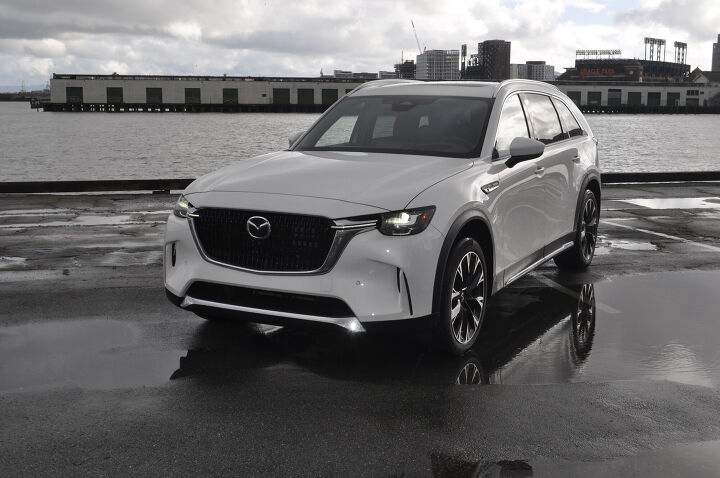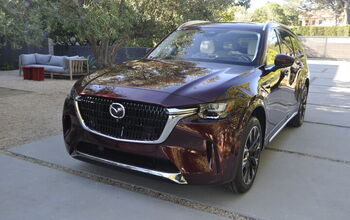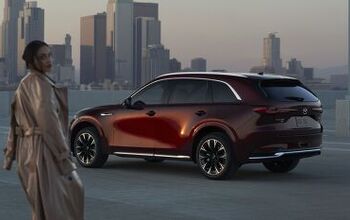2024 Mazda CX-90 Review – Pleasantly Premium

As I crossed the Golden Gate Bridge for the third time, thanks to Google Maps failing at its one primary job (more on that later), I realized I’d be quite late for lunch. No matter, I thought, since I’d get more time with the 2024 Mazda CX-90.
The eventual replacement for the CX-9, the CX-90 is going to be a flagship vehicle for the so-called “zoom-zoom” brand. And while the brand’s image means the company tried – and generally succeeded, more on that below – to make a three-row crossover as sporty as possible, what it really did is come up with a very nice premium three-row crossover.
(Full disclosure: Mazda flew me to San Francisco and fed and housed me for two nights so that I could drive the CX-90. The company also set up certain places for photo opportunities.)
The CX-90 is available in a fairly dizzying array of configurations – there are 11 trim levels and three engines available. Mazda kept it simple for us assembled media by giving us loaded Premium Plus vehicles to drive – one was a Turbo S and one was a plug-in hybrid.
The base engine in the 3.3 Turbo is a 3.3-liter turbocharged inline-six that makes 280 horsepower and 332 lb-ft of torque, while the Turbo S uses a 3.3-liter turbocharged inline-six that makes 340 horsepower and 369 lb-ft of torque. Meanwhile the PHEV mates a 2.5-liter naturally-aspirated four-cylinder to an electric motor for 323 horsepower and 369 lb-ft of torque. There’s a 17.8-kWh battery as part of the setup.
All have standard all-wheel drive with a rear-drive bias, all use eight-speed automatic transmissions, and the gasser sixes have a 48-volt mild hybrid setup.
I snagged the keys – OK, OK, I was assigned – to a Turbo S Premium Plus for my morning drive from The Embarcadero north towards Sonoma. Making my way to the Golden Gate Bridge, I found the CX-90 to be fairly nimble for its size, feeling smaller than it is. It handled late-morning urban traffic with no real trouble.
Heading north on the 101, I found that the CX-90 had a firm but pleasant ride that felt about just right – not sloppy soft nor harsh and tiring. The driver’s seat was comfortable and most exterior noise stayed outside – the main exception was tire noise, which crept in but was fairly easily drowned out by the radio. Engine noise was noticeable when the accelerator was depressed and higher RPMs were summoned for passing, but only in that situation. The growl was fairly pleasant, anyway – not thrashy at all.
Passing punch was plenty, though one must wait for a brief kick down, and you do feel a bit of the CX-90’s weight. Still, as a road tripper, the CX-90 made for a nice companion.
And it was a bit of a road trip. Mazda changed our drive route to avoid some washed-out roads, and for reasons unclear to me, the route was supplied to me via Apple CarPlay and Google Maps instead of the factory navigation system. I won’t bore you with the details but G Maps send me back whence I came, giving me a lot of time to experience the CX-90’s highway behavior.
Before Google Maps sent me wandering all over Marin County, I did have a chance to hit up some curvy roads. Wet weather forced me to slow down and drive more conservatively than I usually would, but I still got a good sense of how the CX-90 behaved in Sport mode.
The Sport mode in the Turbo S is almost too aggressive – it doesn’t just make the steering heavier and call it a day. This is generally appreciated when hustling hard. Mazda has programmed the Sport mode to hold onto gears instead of upshifting so that the power is right there for you on corner exit. The steering feels about right, in terms of weight, and it’s accurate with very little artificial nastiness. It’s cliché but the “zoom-zoom” DNA of the brand is present here. Apologies for using such corpo-speak, but I couldn’t come up with a better way to say it.
Body roll is mostly well-muted, but it does show up sometimes. The rules of physics can only bend so far, and this is a three-row crossover after all.
The brakes were firm and consistent and even saved my bacon, along with some sheet metal, during an honest-to-goodness panic stop that took place on an exit ramp when a Prius came across lanes of traffic and then slowed to a complete stop for reasons known only to the driver. No managing editors or Mazdas were harmed, though my phone became a projectile and the BMW driver between the Prius and I probably needed a change of pants.
Speaking of phones, one of my nitpicks involves the wireless charging pad – it continued to disengage from charging before reengaging, constantly flicking on and off. It’s also a bit narrow – I wonder how larger phones than my ancient iPhone 11 will fit. At least you can plug it into a USB port.
The infotainment system itself is a mixed bag – the large controller knob is placed well and easy to use, but for some reason, the factory screen isn’t touch. Yet Apple CarPlay and Android Auto are touchscreen. As is too often the case, the infotainment screen seems tacked on, but it integrates a bit better than others with a similar design.
The digital gauge cluster is attractive and easy to read, and with the exception of an oddly-placed volume knob for the radio, I found the controls easy to use – and easy to learn quickly. The materials in both vehicles felt class-appropriate, though they were a bit nicer in the more-expensive loaded Premium Plus Turbo S.
Back to the road. The PHEV’s driving dynamics were similar to the Turbo S – Mazda tells me this was the goal. The hybrid setup doesn’t dramatically change handling behavior or ride. Acceleration felt, at least by the seat-of-the-pants metric, about the same for both vehicles. Like with the Turbo S, tire noise intruded. System transitions in the hybrid were noticeable, especially when the gas engine kicked in – at times it was a bit jarring when the gas engine came to life.
I found both powertrains to be good on-road companions, so the choice between the two comes down to cost – the PHEV is a bit cheaper than the Turbo S (and the features mix is a bit different). Well, cost and use case – people who maximize range between gas-station fill-ups will obviously gravitate towards the PHEV.
Mazda has given the CX-90 sleek styling, and while the grille reads as a bit large, the overall package mostly works – it’s an attractive vehicle. Not quite a head-turner – it’s not that splashy – but handsome nonetheless.
Pricing starts at $39,595 for a base 3.3 Turbo Select. Other trims available with that engine include Preferred ($43,335), Preferred Plus ($45,900), Premium ($48,900), and Premium Plus ($52,950).
If you want a PHEV, you get three trim choices: Preferred ($47,445), Premium ($52,900), and Premium Plus ($56,950). Turbo S models are offered as base ($51,750), Premium ($56,450), and Premium Plus ($59,950). Prices don’t include the $1,375 destination fee.
You can configure your CX-90 in six-, seven-, or eight-passenger configurations. You can have three rows of two, a 2/3/2 configuration, a 2/2/3 configuration, or a 2/3/3 configuration. I managed to get in the rear seat in a 2/2/3 PHEV without a ton of trouble, but the sloping roofline feels a little claustrophobic for us taller adults, and my plentiful legroom went away when the second-row seat was all the way back. Exiting was not graceful.
Children and smaller adults should be fine, though.
The list of available features is too long to fully include here, but it does include premium paint colors, Apple CarPlay, Android Auto, navigation, Bluetooth, satellite radio, paddle shifters, keyless entry, keyless starting, the 10.25-inch infotainment screen, a seven-inch digital gauge cluster, front- and second-row dual USB ports, LED lighting, heated front seats, a power liftgate, wireless phone charging, wireless CarPlay and Android Auto, head-up display, Type-C USB ports, premium audio, heated steering wheel, cooled front seats, larger infotainment and instrument cluster screens, 19-inch wheels, 21-inch wheels, power panoramic sunroof, a hands-free power liftgate, leather seats, and driver personalization.
Other drive modes include off-road, towing, and an EV mode for the PHEV.
Available advanced driver-aid systems include emergency lane-keeping, blind-spot assist, secondary collision reduction system, traffic-sign recognition, 360-degree camera, front cross-traffic alert with front cross-traffic braking (I found this one to be a bit too intrusive when stopped at a stop sign where cross traffic didn’t stop), smart brake support when in reverse, and front and rear parking sensors.
Welp, I am tired after all that.
Fuel economy is projected at 24/28/25 for the base six, 23/28/25 for the Turbo S, and not yet listed for the PHEV.
Few crossover buyers are really, truly searching for sport, but for those who want it, they’ve got it in the CX-90. Perhaps more importantly for Mazda, the brand has come up with a premium three-row crossover that looks and feels the part. Its only dynamic flaw when being driven gently, commuter-style, is tire noise. Other problems, such as inconsistent wireless charging, are minor annoyances.
The price is a bigger problem. The good news is that lower trims are fairly well-equipped and the base six seems powerful enough on paper. Similarly, the interior materials on the Premium Plus vehicles do feel price appropriate. That said, $60K for any three-row crossover of this size, regardless of on-road performance or pre-conceived notions of a brand that are based on ancient history, feels a tad dear.
Then again, you get what you pay for. A premium package that feels pleasant and just works well with a side of well-tuned sportiness might just be worth every penny.
[Images © 2023 Tim Healey/TTAC]
Become a TTAC insider. Get the latest news, features, TTAC takes, and everything else that gets to the truth about cars first by subscribing to our newsletter.

Tim Healey grew up around the auto-parts business and has always had a love for cars — his parents joke his first word was “‘Vette”. Despite this, he wanted to pursue a career in sports writing but he ended up falling semi-accidentally into the automotive-journalism industry, first at Consumer Guide Automotive and later at Web2Carz.com. He also worked as an industry analyst at Mintel Group and freelanced for About.com, CarFax, Vehix.com, High Gear Media, Torque News, FutureCar.com, Cars.com, among others, and of course Vertical Scope sites such as AutoGuide.com, Off-Road.com, and HybridCars.com. He’s an urbanite and as such, doesn’t need a daily driver, but if he had one, it would be compact, sporty, and have a manual transmission.
More by Tim Healey
Latest Car Reviews
Read moreLatest Product Reviews
Read moreRecent Comments
- Lorenzo If it's over 30 years old and over 80k miles, and not a classic, it's a parts car, worth no more than 20% of original price.
- Dusterdude No mileage noted on a 33 year old car means likely well north of 300k + miles , along with issues noted , should equate to an ask price of less than $3k
- Ajla IMO, something like this really should be naturally-aspirated.
- Kjhkjlhkjhkljh kljhjkhjklhkjh Unless they are solid state batteries you BAN THEM. I like EVs... but EVs like to burn ... for days
- Kjhkjlhkjhkljh kljhjkhjklhkjh uh .. it looks like a VW golf got the mumps












































Comments
Join the conversation
Mazda makes cars and SUVs that drive responsively. The vehicles tend to avoid risky tech decisions, but they usually last a long time with little required repair. The vehicles are designed with style in mind. Mazda even lets you choose options and colors when you buy your car. These things make Mazda special - if only because many other automakers have been abandoning the field in one or more of these areas. For these reasons, I will always shop Mazda any time I need a new vehicle.
Discover 7 Car Cup Holders to Enhance Your Driving Experience: https://digitalmarketrev.com/top-7-car-cup-holders-of-2023/